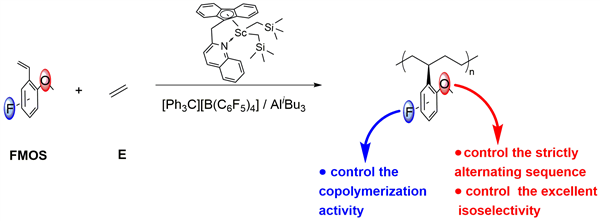Isospecific alternating copolymerization of unprotected polar styrenes and ethylene by the Cs symmetric scandium precursor via synergistic effects of two substituent groups
作者:Tiantian Wang , Chunji Wu , Baoli Wang* , Dongmei Cui*
关键字:Coordination polymerization, Sequence-controlled copolymerization, Stereoselectivity, Functionalized polyolefin, Synergistic effect
论文来源:期刊
具体来源:Giant, 7, 2021, 100061
发表时间:2021年
Coordination polymerization of polar monomers bearing two functional groups has been a formidable challenge due to much higher poisonous possibility. In this contribution, we reported the coordination (co)polymerization of FMOSs bearing two functional groups, 4-fluoro-2-methoxystyrene (2,4-FMOS), 5-fluoro-2-methoxystyrene (2,5-FMOS) and 6-fluoro-2-methoxystyrene (2,6-FMOS) using the quinolyl methylene fluorenyl complexes (Flu-CH2-Qu) Sc (CH2SiMe3)2 (1) and (Flu-CH2 -Qu)Y(CH2SiMe3) 2 (THF) (2) and the β-diketiminato complex (bis(2,6-dimethyl anilido)ketimine)Y(CH2SiMe3)2(THF) (3). Excellent syndiotactic P(2,6-FMOS) ( rrrr > 99%) was isolated from complex 1 in a moderate activity, while, almost atactic P(2,6-FMOS) was obtained by complexes 2 and 3 . Polymerizations of both 2,4-FMOS and 2,5-FMOS showed high activities and excellent syndioselectivity ( rrrr > 99%) by complexes 1 and 2 , and perfect isoselectivity ( mmmm > 99%) by complex 3 . Moreover, copolymerizations of ethylene (E)/2,4-FMOS and E/2,6-FMOS catalyzed by complex 1 , respectively, displayed the positive comonomer effect in much higher activities than those of E/2,5-FMOS and E/2-methoxystyrene (MOS) to afford perfect isotactic ( mmmm > 99%) alternating products E- alt -FMOS. This work represents the first example of isoselective alternating copolymerization of E and the unprotected polar styrenes, in particular those bearing two polar substituents. The reasons for the formation of isoselective and alternating structures of polymers might be attributed to the unique synergistic effects of fluorine and o -methoxy groups. The mechanism was elucidated by the DFT calculations.
